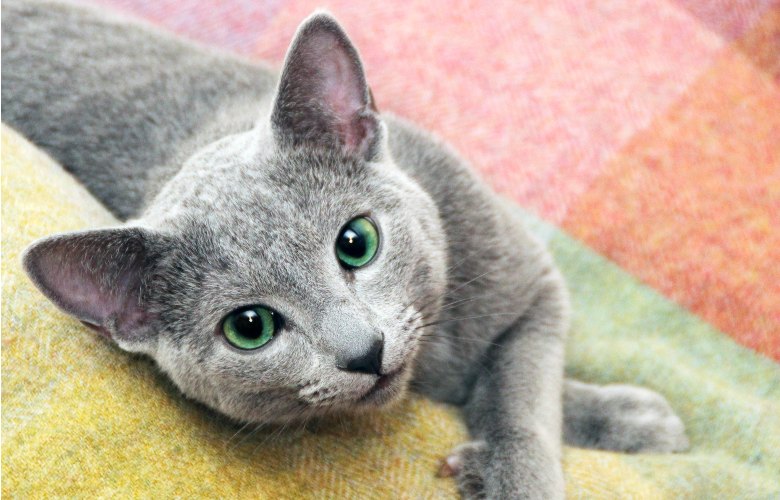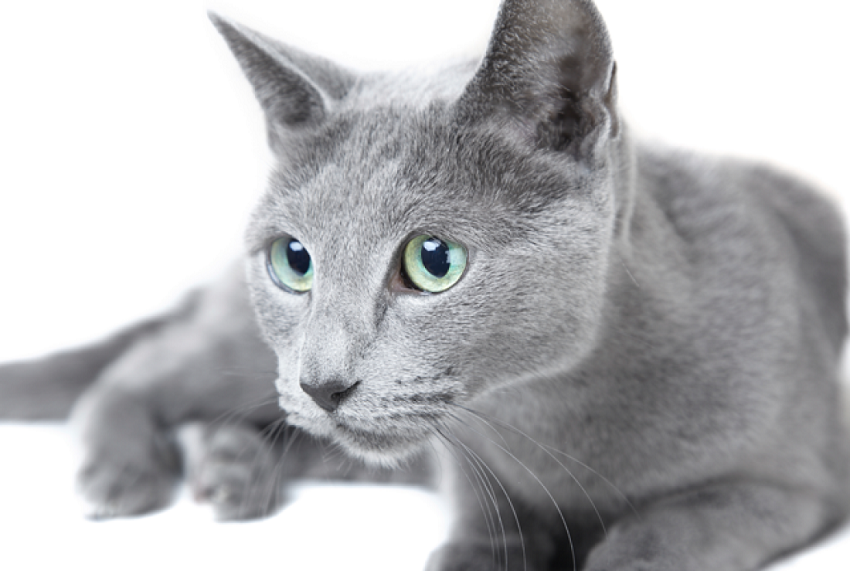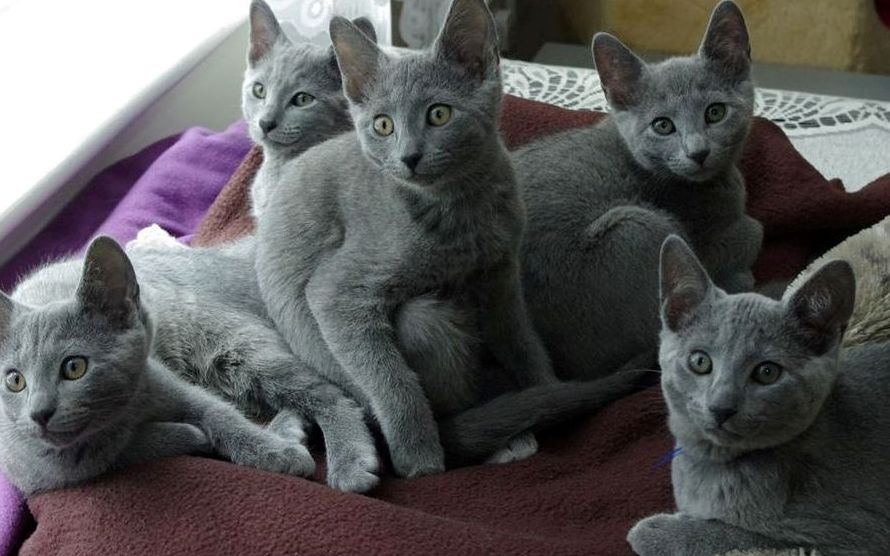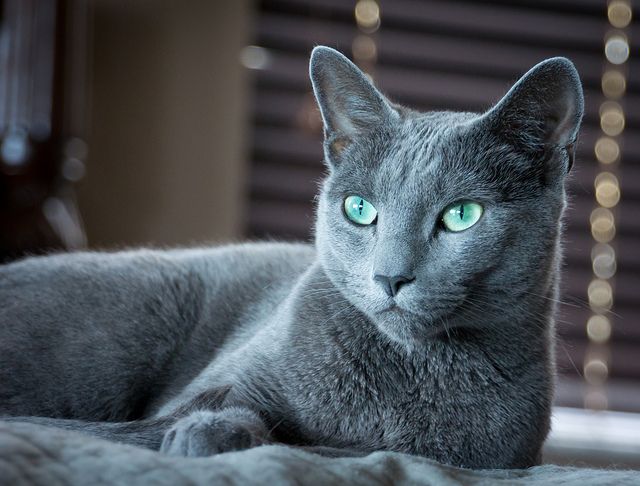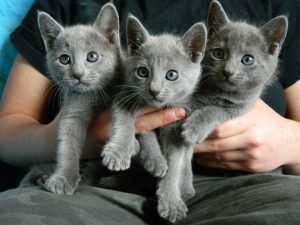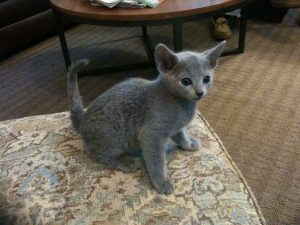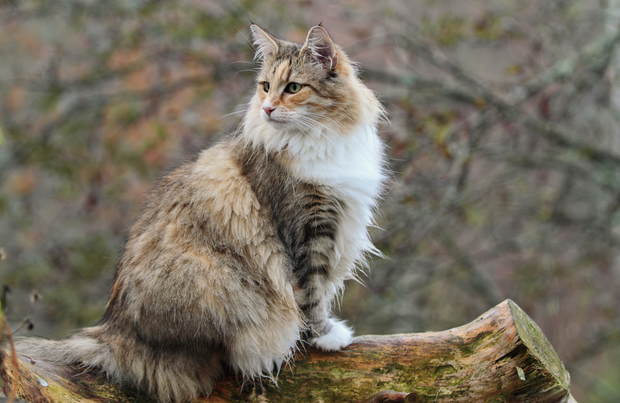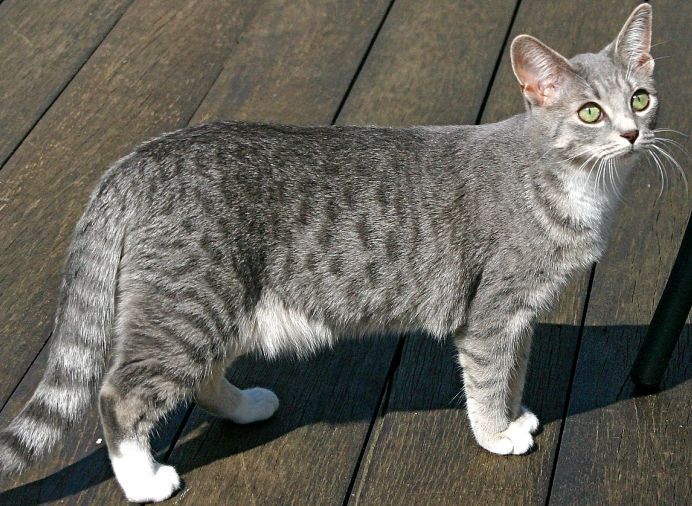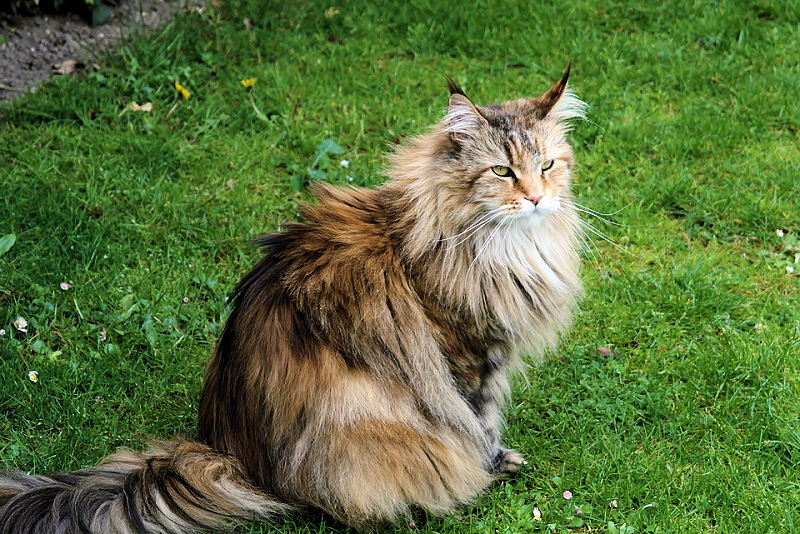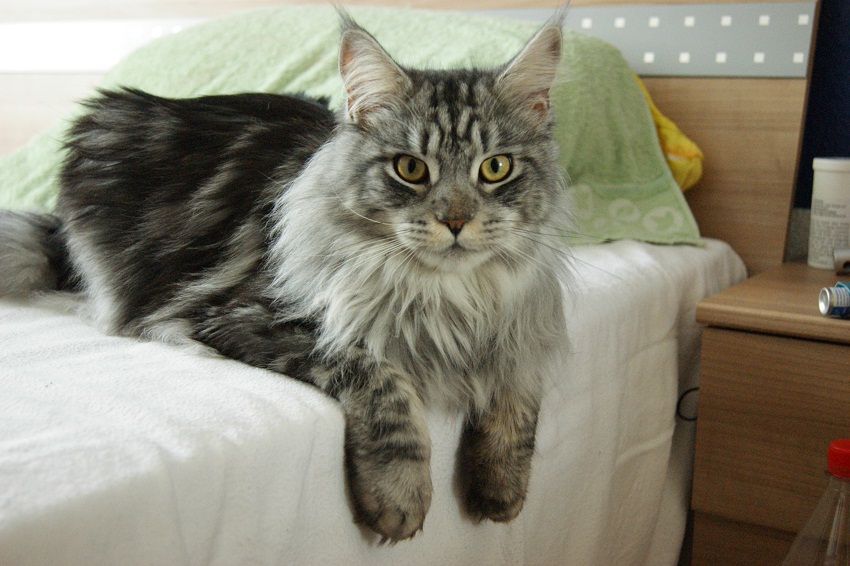Russian Blue
Elegant and gorgeous, the Russian Blue with its shiny, shimmering silver-blue coat and a pair of sparkling green eyes is a beauty to watch. Often rumored of being the Czar’s as well as Queen Victoria’s favorite pet, their pleasant face and appealing smile, along with an intelligent disposition, make them an excellent house cat.
Quick Information
Physical Appearance & Size
| Body Type: | Medium |
| Physical Appearance: | Long, slender, fine-boned and elegant body, robust and muscular built, double layered short, thick furry coat, broad head, straight nose, widely set, round eyes slanting at the corners, large, erect ears, and a long, well-proportioned tail. |
| How big do they get (Size): | 7- 15 pounds |
Colors & Patterns
| Coat type: | Short, plush, soft, velvety. dense, smooth |
| Color: | Greyish-blue with silver tips |
| Eye color: | Yellow in kittens, bright emerald green in cats |
| Pattern: | Ticked |
Other Characteristics
| Litter size: | Approximately 3 |
| Behavioral Characteristics: | Friendly, intelligent, playful, curious, calm, gentle |
| Lap Cat: | Yes |
| Shedding ( Do they shed): | Moderately |
| Vocalization: | Low |
| Good with Children: | Yes |
| Is it hypoallergenic: | No |
| Country (Where do they come from): | Russia |
| Competitive Registration/ Qualification: | CFA, FIFe, TICA, AACE, ACF, ACFA/CAA, CCA-AFC, GCCF |
History and Origin
There is not much concrete fact regarding the origination of the Russian Blue, and most of the details available are based on myths as well as assumptions. In fact, many people believe it to be a natural breed that gradually evolved in Northern Russia’s Archangel Isles, developing a dense and plush coat to get accustomed to the long, chilly winters.
There have also been rumors of these cats to have been kept as pets by the Czars. Stepping out from its homeland, it reached parts of northern Europe and Great Britain during in the 1860s, with sailors taking them to these distant lands by ship. It was officially exhibited in England’s Crystal Palace in the year 1875, by the name of Archangel Cat. It got a class of its own in 1912 for competitions until which it competed with other blue felines.
Though imported to the U.S.A in the first half of the 1900s, they gained popularity only after the Second World War, when the breeders took great initiatives towards developing the Russian Blue of the present time, as their numbers had drastically deteriorated post-war. To raise their numbers they were crossed with the Bluepoint Siamese as well as the British Blues, while Scandinavian breeders crossed Blue cats imported from Finland with Blue Siamese.
However, this crossbreeding resulted in a decline in their personality and shape. Hence, to revive the original Russian Blue, the Scandinavian and British Blues were again crossed, with the Siamese breed being outbred. It is years of selective breeding that have helped them to attain a unique and distinctive appearance.
They have also been used in creating breeds like the Havana Brown as well as modifying existing ones such as the Nebelung. At present these cats have been put into use in Italy to improve the Oriental Shorthair’s health as well as giving it a robust appearance.
Variations of the Russian Blue developed by crossing this breed with domestic white cats, known as Russian Blacks and Russian Whites, were accepted in South Africa, the United Kingdom, and Australia, though the FIFe and CFA do not recognize any Russian Blue variation.
Temperament and Personality
- Are friendly, affectionate and devoted towards their family, but possesses a shy and reserved attitude when acquainted with strangers.
- Tends to get nervous or apprehensive when put in a strange or unknown environment.
- Understands their owner’s mood and may often wait to greet you at the door when you return home after a tiring day.
- Has a sharp sense of intelligence and always analyses something in depth before engaging in it. Hence they do not get into trouble often.
- Possesses an immense observation capacity, often following their master’s way of doing a thing like opening a container or cupboard.
- Are quiet barring mealtime, but would speak if you interact with them, also developing an extensive vocabulary stock in no time.
- Is gentle and friendly with kids, including those who might handle it clumsily and might even get out of their way to save any unpleasant occurrence rather than causing harm to them.
- Has a sensitive nature and detests being left out or ignored.
- Detests changes and might throw a fit if its mealtime is altered because of any reason.
- Enjoys a game of fetch and would often bring your toys demanding you to throw it at them.
- Has graceful movements and goes about as smoothly as a ballerina.
- Is a cleanliness freak and is reluctant to enter a litter box if it is unkempt or dirty.
- Has an immense liking for food and always crave for more once they finish the contents on their platter.
- Loves staying in the confines of a home, though it can manage conveniently outdoors due to its coat that can adapt well to cold weathers.
Who is the Russian Blue good for
- Families looking for a perfect lap and companion cat to cuddle and play.
- Those who desire to have an elegant cat with stylish moves.
- Houses having older kids who would not knock it down since this breed might get tensed on encountering such situations.
- People looking for a gentle and courteous family pet who would maintain decorum yet amuse and entertain them with their several antics.
- Owners in need of a well-behaved feline who would not be destructive and bring the house down.
Care
Since they shed less and are clean cats, the Russian Blue needs minimal grooming, with bi-weekly brushing being enough to maintain its soft, plush fur. Bathe it only when necessary and follow the other grooming requirements like brushing its teeth, trimming its nails as well as cleaning its eyes and ears to keep infections at bay.
These natural breeds are healthy and hardy, not suffering from any known genetic issues.
Training
Being an intelligent cat, training the Russian Blue would not be too much of an ordeal, and the method of positive reinforcement would be sufficing. Taking them to participate in a show might still be challenging as they do not do well in such places because of their nervousness. To help it get rid of its shyness, acquaint it to unknown people from the time it is a kitten. You can use food as bait keeping its weakness for edibles in mind.
Feeding
Give it dry cat food on a regular basis alongside a healthy diet that might satisfy its nutrient requirement. Since it has a fascination for food, ensure to limit its intake lest it might have obesity problems.
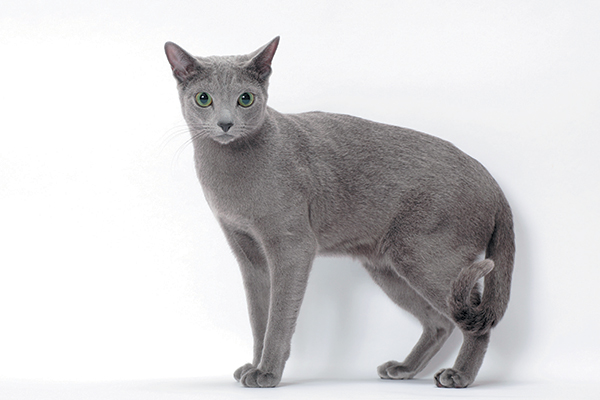
Russian Blue 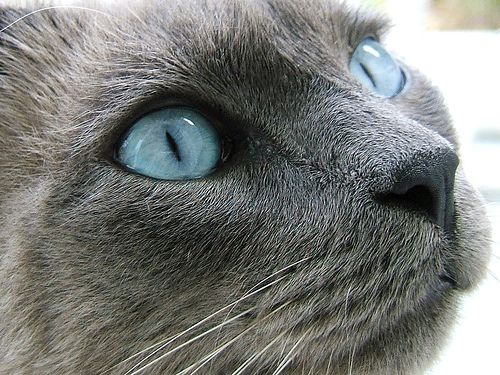
Russian Blue with Blue Eyes 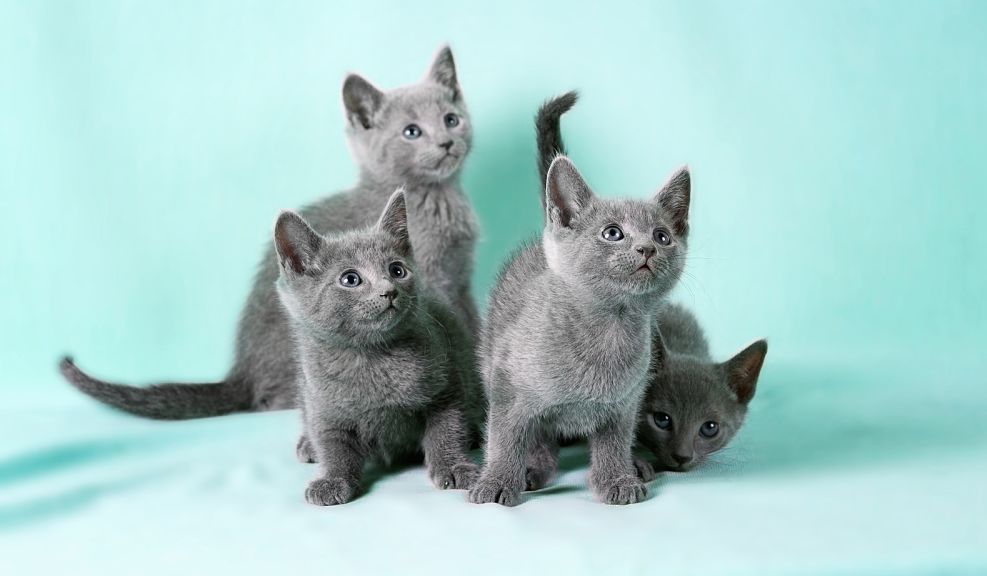
Russian Blue Kittens Picture
Interesting Facts
- Snooch and Eben, characters of the comic “Two Lumps” are Russian Blues.
- Bluestar in the novel series Warriors is also a Russian Blue.
- A male Russian Blue named GC Maja Acre Igor II, won the CFA Grand Championship in 1964.

